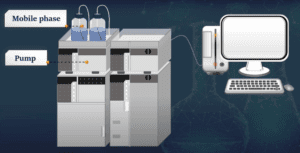| X-ray Powder Diffraction (XRPD) | Used for identifying and characterizing crystalline materials. Essential for studying the polymorphic forms of active pharmaceutical ingredients (APIs). |
| Laser Diffraction Particle Size Analyzer | Measures particle size distribution using laser diffraction. Important for quality control of powders and suspensions. |
| Total Organic Carbon (TOC) Analyzer | Measures the total organic carbon content in water and other liquids. Critical for monitoring the purity of water used in pharmaceutical production. |
| Atomic Absorption Spectroscopy (AAS) | Determines the concentration of metals in samples. Used for trace metal analysis in raw materials and finished products. |
| Inductively Coupled Plasma Mass Spectrometry (ICP-MS) | Provides highly sensitive detection of trace elements. Used for elemental impurity analysis in pharmaceuticals. |
| Inductively Coupled Plasma Optical Emission Spectrometry (ICP-OES) | Analyzes elemental composition through optical emission. Used for multi-element analysis in various samples. |
| Potentiometric Titrator | Measures the potential difference between electrodes to determine the endpoint of a titration. Used for various titrimetric analyses. |
| Circular Dichroism (CD) Spectrometer | Analyzes the chiral properties of molecules. Important for studying the stereochemistry of APIs and excipients. |
| Flame Photometer | Measures the concentration of certain metal ions, such as sodium and potassium, by analyzing the emission of light from a flame. |
| Polarimeter | Measures the angle of rotation caused by passing polarized light through an optically active substance. Used for determining the concentration and purity of chiral compounds. |
| Raman Spectroscopy | Provides molecular fingerprinting through vibrational modes of molecules. Useful for identifying and characterizing chemical compounds. |
| Turbidimeter | Measures the turbidity (cloudiness) of liquid samples. Used for assessing the clarity of solutions and suspensions. |
| Zeta Potential Analyzer | Measures the zeta potential of particles in suspension. Important for understanding the stability of colloidal dispersions. |
| Dynamic Light Scattering (DLS) Analyzer | Measures particle size distribution based on light scattering. Used for analyzing nanoparticles and sub-micron particles in suspensions. |
| Automatic Dissolution Sampler | Automates the sampling process during dissolution testing. Enhances efficiency and reproducibility in dissolution studies. |
| Nitrogen/Protein Analyzer | Measures nitrogen content to determine protein concentration. Used in the analysis of protein-based pharmaceuticals. |
| Osmometer | Measures the osmotic concentration of solutions. Important for formulating isotonic solutions in pharmaceuticals. |
| Gas Chromatography-Mass Spectrometry (GC-MS) | Combines gas chromatography and mass spectrometry for detailed analysis of volatile compounds. Used for impurity profiling and residual solvent analysis. |
| High-Resolution Mass Spectrometry (HRMS) | Provides high-accuracy mass measurements. Used for detailed molecular analysis and identification of unknown compounds. |
| Capillary Electrophoresis (CE) | Separates ionic species based on their size and charge. Used for analyzing complex mixtures, including proteins and nucleotides. |
| Field-Flow Fractionation (FFF) | Separates particles and macromolecules based on their size and mass. Used for characterizing nanoparticles and large biomolecules. |
| Centrifuge | Separates components in a mixture based on their density. Essential for preparing samples and isolating components in pharmaceutical analysis. |
| Lyophilizer (Freeze Dryer) | Removes water from samples by sublimation. Used for sample preservation and preparation in analytical testing. |
| Moisture Balance | Measures moisture content using heat. Provides quick and accurate moisture analysis for quality control. |
| Sterility Testing Isolator | Provides a controlled environment for conducting sterility tests on pharmaceutical products. Ensures the absence of viable contaminating microorganisms. |
| Microbial Air Sampler | Collects air samples for microbial analysis. Used for monitoring air quality in clean rooms and controlled environments. |
| Automated Compendial Dissolution System | Integrates multiple dissolution testers with automated sampling and analysis. Increases throughput and consistency in dissolution testing. |
| Vibrational Spectroscopy | Includes techniques like near-infrared (NIR) and mid-infrared (MIR) spectroscopy. Used for qualitative and quantitative analysis of pharmaceutical substances. |
| Digital Density Meter | Measures the density of liquids and gases with high precision. Used for quality control of formulations and excipients. |
| Titration Automation Workstation | Automates various titration processes, increasing efficiency and accuracy in volumetric and coulometric titrations. |
| Digital Refractometer | Measures refractive index with high precision. Used for concentration and purity analysis of liquid samples. |

